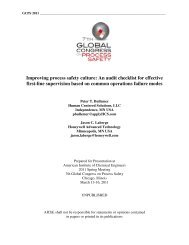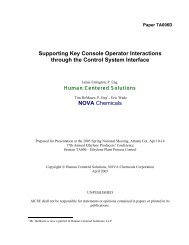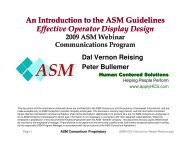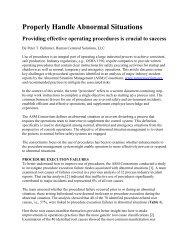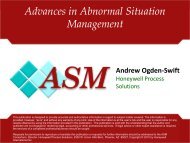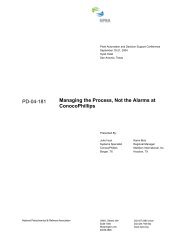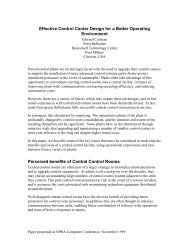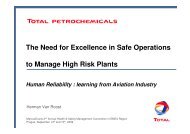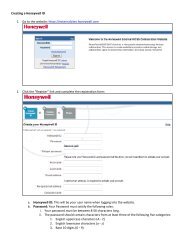Abnormal Situation Management and Human Side of Safety - ASM ...
Abnormal Situation Management and Human Side of Safety - ASM ...
Abnormal Situation Management and Human Side of Safety - ASM ...
Create successful ePaper yourself
Turn your PDF publications into a flip-book with our unique Google optimized e-Paper software.
<strong>Abnormal</strong> <strong>Situation</strong> <strong>Management</strong> <strong>and</strong><br />
the <strong>Human</strong> <strong>Side</strong> <strong>of</strong> Process <strong>Safety</strong><br />
ERTC<br />
15 th Annual Meeting<br />
30 November 2010<br />
Istanbul, Turkey<br />
Dr. Peter Bullemer<br />
<strong>Human</strong> Centered Solutions<br />
pbullemer@applyHCS.com<br />
Jason Laberge<br />
Honeywell Advanced Technology<br />
jason.laberge@honeywell.com<br />
<strong>ASM</strong><br />
Paper presented on behalf <strong>of</strong> the <strong>Abnormal</strong><br />
<strong>Situation</strong> <strong>Management</strong>® R&D Consortium<br />
<strong>ASM</strong>® <strong>and</strong> <strong>Abnormal</strong> <strong>Situation</strong> <strong>Management</strong>® are registered trademarks <strong>of</strong> Honeywell International
<strong>ASM</strong><br />
Key Message<br />
• In recent years, many organizations have been<br />
striving to improve process safety management<br />
performance.<br />
• One opportunity for improving process safety<br />
performance is to reduce the probability <strong>of</strong><br />
human error through effective abnormal<br />
situation management practices.<br />
ERTC 15th Annual Meeting<br />
30 November 2010<br />
Istanbul, Turkey<br />
Page 2<br />
Dr. Peter Bullemer<br />
<strong>Human</strong> Centered Solutions<br />
pbullemer@applyHCS.com
<strong>ASM</strong><br />
<strong>Abnormal</strong> <strong>Situation</strong> <strong>Management</strong>®<br />
A Joint Research <strong>and</strong> Development Consortium<br />
Founded in 1994<br />
Challenges associated<br />
with human side <strong>of</strong><br />
process safety have been<br />
a focus <strong>of</strong> the <strong>Abnormal</strong><br />
<strong>Situation</strong> <strong>Management</strong>®<br />
(<strong>ASM</strong>) Consortium for the<br />
past fifteen years.<br />
<strong>Human</strong> Centered Solutions<br />
Helping People Perform<br />
www.asmconsortium.org<br />
ERTC 15th Annual Meeting<br />
30 November 2010<br />
Istanbul, Turkey<br />
Page 3<br />
UCLA<br />
Dr. Peter Bullemer<br />
<strong>Human</strong> Centered Solutions<br />
pbullemer@applyHCS.com
<strong>ASM</strong><br />
<strong>Abnormal</strong> <strong>Situation</strong> <strong>Management</strong>®<br />
A Joint Research <strong>and</strong> Development Consortium<br />
Founded in 1994<br />
Enable operating teams<br />
to proactively manage<br />
their plants to maximize<br />
safety <strong>and</strong> minimize<br />
environmental impact<br />
while allowing the<br />
processes to be pushed<br />
to their optimal limits.<br />
<strong>Human</strong> Centered Solutions<br />
Helping People Perform<br />
www.asmconsortium.org<br />
ERTC 15th Annual Meeting<br />
30 November 2010<br />
Istanbul, Turkey<br />
Page 4<br />
UCLA<br />
Dr. Peter Bullemer<br />
<strong>Human</strong> Centered Solutions<br />
pbullemer@applyHCS.com
<strong>ASM</strong><br />
<strong>Abnormal</strong> <strong>Situation</strong> Definition<br />
• An industrial process is being disturbed <strong>and</strong> the<br />
automated control system can not cope...<br />
• Consequently, the operations team must<br />
intervene to supplement the control system.<br />
• Impacts pr<strong>of</strong>itability in multiple ways:<br />
Product Quality<br />
Equipment Damage<br />
Loss <strong>of</strong> Life<br />
Job Satisfaction<br />
Product Thruput<br />
Personal Injury<br />
ERTC 15th Annual Meeting<br />
30 November 2010<br />
Istanbul, Turkey<br />
Page 5<br />
Dr. Peter Bullemer<br />
<strong>Human</strong> Centered Solutions<br />
pbullemer@applyHCS.com
<strong>ASM</strong><br />
Process<br />
<strong>Safety</strong><br />
Incidents<br />
<strong>Abnormal</strong><br />
<strong>Situation</strong><br />
Incidents<br />
Effective<br />
Operations<br />
Practices<br />
<strong>ASM</strong> Relation to PSM<br />
<strong>Safety</strong> Pyramid Illustration<br />
Major Incidents<br />
Incidents above<br />
threshold for Process<br />
<strong>Safety</strong> Incident<br />
Minor Incidents<br />
Incidents below impact<br />
threshold for PS Incident<br />
Near Miss<br />
System Failures that<br />
could lead to an incident<br />
Unsafe Behaviors<br />
Insufficient Operating Discipline<br />
ERTC 15th Annual Meeting<br />
30 November 2010<br />
Istanbul, Turkey<br />
Illustration based on: CCPS Process <strong>Safety</strong> Leading <strong>and</strong> Lagging Metrics.<br />
Page 6<br />
Dr. Peter Bullemer<br />
<strong>Human</strong> Centered Solutions<br />
pbullemer@applyHCS.com
<strong>ASM</strong><br />
Managing <strong>Abnormal</strong> <strong>Situation</strong>s<br />
Operational Modes <strong>and</strong> Critical Systems Perspective<br />
Operational<br />
Modes:<br />
Plant States:<br />
Critical<br />
Systems:<br />
Operational<br />
Goals:<br />
Plant<br />
Activities:<br />
Emergency<br />
Disaster<br />
Accident<br />
Out <strong>of</strong><br />
Control<br />
Area Emergency Response<br />
System<br />
Site Emergency Response<br />
System<br />
Physical <strong>and</strong> Mechanical<br />
Containment System<br />
<strong>Safety</strong> Shutdown,<br />
Minimize<br />
Impact<br />
Bring to<br />
Safe State<br />
Firefighting<br />
First Aid<br />
Rescue<br />
Evacuation<br />
<strong>Abnormal</strong><br />
<strong>Abnormal</strong><br />
Protective Systems,<br />
Hardwired Emergency Alarms<br />
DCS Alarm System<br />
Return to<br />
Normal<br />
Manual Control &<br />
Troubleshooting<br />
Decision Support System<br />
Normal<br />
Normal<br />
Process Equipment,<br />
DCS, Automatic Controls<br />
Plant <strong>Management</strong> Systems<br />
Keep Normal<br />
Preventative<br />
Monitoring &<br />
Testing<br />
ERTC 15th Annual Meeting<br />
30 November 2010<br />
Istanbul, Turkey<br />
Page 7<br />
Dr. Peter Bullemer<br />
<strong>Human</strong> Centered Solutions<br />
pbullemer@applyHCS.com
<strong>ASM</strong><br />
Managing <strong>Abnormal</strong> <strong>Situation</strong>s<br />
<strong>Human</strong> Supervisory Control<br />
Process<br />
State<br />
Operator Mental & Physical Activities<br />
Orienting<br />
Evaluating<br />
Acting<br />
Inputs from Process<br />
(sensors, analyzers, radios,<br />
video, instructions, sounds &<br />
smells)<br />
(1) Sensing,<br />
Perception,<br />
<strong>and</strong>/or<br />
Discrimination<br />
(2) Analysis,<br />
Interpretation,<br />
<strong>and</strong>/or<br />
(3) Projection<br />
Physical <strong>and</strong>/or<br />
Verbal<br />
Response<br />
Outputs to Process<br />
(SP, OP%, Manual<br />
adjustments)<br />
<strong>Situation</strong> Awareness (1-3)<br />
Internal Feedback<br />
Assessing<br />
External Feedback<br />
• This model operationalizes the human processing<br />
elements in the operator’s supervisory control<br />
responsibilities for managing abnormal situations<br />
Adaptation <strong>of</strong> Supervisory Control Activity models <strong>of</strong> Jens Rasmussen <strong>and</strong> David Woods - CMA.<br />
ERTC 15th Annual Meeting<br />
30 November 2010<br />
Istanbul, Turkey<br />
Page 8<br />
Dr. Peter Bullemer<br />
<strong>Human</strong> Centered Solutions<br />
pbullemer@applyHCS.com
<strong>ASM</strong><br />
Sources <strong>of</strong> <strong>Abnormal</strong> Events<br />
Often Preventable<br />
Equipment<br />
40%<br />
Process<br />
20%<br />
People<br />
40%<br />
People:<br />
• Fail to detect problems in<br />
reams <strong>of</strong> data<br />
• Are required to make<br />
hasty interventions<br />
• May be unable to make<br />
consistent responses<br />
• May be unable to<br />
communicate well<br />
Mostly Preventable<br />
Almost Always<br />
Preventable<br />
Established in literature ; confirmed by 18 plant studies - US, Canada, & Europe<br />
ERTC 15th Annual Meeting<br />
30 November 2010<br />
Istanbul, Turkey<br />
Page 9<br />
Dr. Peter Bullemer<br />
<strong>Human</strong> Centered Solutions<br />
pbullemer@applyHCS.com
Freq u ency<br />
# D ays<br />
# D ays<br />
Frequency<br />
300<br />
250<br />
200<br />
150<br />
100<br />
30 0<br />
25 0<br />
20 0<br />
15 0<br />
10 0<br />
50<br />
0<br />
50<br />
280<br />
0<br />
280<br />
4 57<br />
112<br />
290<br />
290<br />
4 63<br />
300<br />
115<br />
300<br />
310<br />
4 68<br />
310<br />
118<br />
320<br />
320<br />
4 74<br />
121<br />
330<br />
330<br />
4 80<br />
340<br />
124<br />
340<br />
350<br />
350<br />
4 86<br />
127<br />
360<br />
360<br />
4 92<br />
130<br />
370<br />
370<br />
380<br />
1 3<br />
4 97<br />
380<br />
390<br />
390<br />
5 03<br />
136<br />
400<br />
400<br />
139<br />
5 09<br />
410<br />
410<br />
420<br />
420<br />
142<br />
5 15<br />
430<br />
430<br />
145<br />
5 20<br />
440<br />
440<br />
148<br />
His togram<br />
Pro duction rate<br />
450<br />
5 26<br />
Feed Rate<br />
450<br />
460<br />
460<br />
151<br />
5 32<br />
470<br />
470<br />
154<br />
5 38<br />
480<br />
480<br />
157<br />
490<br />
490<br />
5 43<br />
500<br />
500<br />
160<br />
5 49<br />
510<br />
510<br />
163<br />
520<br />
5 55<br />
520<br />
530<br />
1 6<br />
530<br />
5 61<br />
540<br />
540<br />
169<br />
5 67<br />
550<br />
550<br />
172<br />
560<br />
5 72<br />
560<br />
570<br />
174<br />
570<br />
5 78<br />
580<br />
580<br />
1 7<br />
5 84<br />
590<br />
590<br />
180<br />
600<br />
600<br />
5 90<br />
610<br />
183<br />
150 3<br />
610<br />
5 95<br />
620<br />
620<br />
18<br />
16<br />
14<br />
12<br />
10<br />
8<br />
6<br />
4<br />
2<br />
0<br />
<strong>ASM</strong><br />
3.2%<br />
5.8%<br />
<br />
5.8%<br />
Histogram<br />
24.2M<br />
$24.2M<br />
Total Feed<br />
$38.5 M<br />
38.5M<br />
<br />
Making the Business Case<br />
Unexpected Events Cost 3-8% <strong>of</strong> Capacity<br />
~ $10 Billion annually in lost production !<br />
Source: <strong>ASM</strong> Consortium Research<br />
Plant Operating Target<br />
20<br />
15<br />
10<br />
5<br />
0<br />
33.5M<br />
$33.5 M<br />
Total Feed<br />
Rate<br />
Ra te<br />
Operational Constraints<br />
Summarized Production Data<br />
Days per Year<br />
Plant Incidents<br />
Optimization efforts<br />
Plant Capacity Limit<br />
< 60%<br />
ERTC 15th Annual Meeting<br />
30 November 2010<br />
Istanbul, Turkey<br />
Daily Production Level<br />
Page 10<br />
95% 100%<br />
Dr. Peter Bullemer<br />
<strong>Human</strong> Centered Solutions<br />
pbullemer@applyHCS.com
<strong>ASM</strong><br />
Persistent Paradoxes<br />
• Paradox <strong>of</strong> Automation<br />
– Better automation leads to more sophisticated processes.<br />
– More sophisticated processes leads to more opportunities for error.<br />
– We tend to “fix” the increasing errors with still more automation.<br />
• Paradox <strong>of</strong> Reliability<br />
– Better equipment reliability leads to fewer operator interventions<br />
– Fewer operator intervention leads to fewer opportunities to learn<br />
from experience<br />
– Less experiential knowledge <strong>and</strong> skill leads to more human errors<br />
– We attempt to “fix” the increasing human error with equipment<br />
reliability improvements<br />
• Consequently, when things go wrong, people have difficulty<br />
intervening to correct the problem.<br />
• Need to better underst<strong>and</strong> how to break the cycles <strong>and</strong> support<br />
human intervention activities<br />
ERTC 15th Annual Meeting<br />
30 November 2010<br />
Istanbul, Turkey<br />
Page 11<br />
Dr. Peter Bullemer<br />
<strong>Human</strong> Centered Solutions<br />
pbullemer@applyHCS.com
<strong>ASM</strong><br />
<strong>ASM</strong> Incident Analysis Study<br />
Project Objectives<br />
• Underst<strong>and</strong> relation between ineffective<br />
operations practices <strong>and</strong> process industry<br />
incidents<br />
–Systematically analyze incidents to determine<br />
common operational practice failure modes<br />
–Identify root causes <strong>of</strong> common operational<br />
practice failure modes<br />
–Why do failures occur ACROSS incidents<br />
This research study was sponsored by the <strong>Abnormal</strong> <strong>Situation</strong> <strong>Management</strong>® (<strong>ASM</strong>®)<br />
Consortium.<br />
ERTC 15th Annual Meeting<br />
30 November 2010<br />
Istanbul, Turkey<br />
Page 12<br />
Dr. Peter Bullemer<br />
<strong>Human</strong> Centered Solutions<br />
pbullemer@applyHCS.com
<strong>ASM</strong><br />
<strong>ASM</strong> Incident Analysis Study<br />
Common Operations Failures<br />
Top 10 Operations Failures<br />
# %<br />
Hazard analysis/ communication 79 15%<br />
First-line leadership 65 12%<br />
Continuous improvement 60 11%<br />
<strong>Safety</strong> culture 36 7%<br />
Initial <strong>and</strong> refresher training 30 6%<br />
Task communications 29 5%<br />
Comprehensive MOC 28 5%<br />
Cross functional communication 23 4%<br />
Compliance with procedures 15 3%<br />
Design guidelines <strong>and</strong> st<strong>and</strong>ards 14 3%<br />
Other failure modes 160 30%<br />
TOTAL 539<br />
• 32 incidents were<br />
analyzed using TapRoot<br />
incident investigation<br />
methodology<br />
Public Site Total<br />
USA 14 7 21<br />
Non<br />
USA 6 5 11<br />
Total 20 12 32<br />
• Top 10 covered 70% <strong>of</strong><br />
identified operations<br />
practice failures<br />
ERTC 15th Annual Meeting<br />
30 November 2010<br />
Istanbul, Turkey<br />
Page 13<br />
Dr. Peter Bullemer<br />
<strong>Human</strong> Centered Solutions<br />
pbullemer@applyHCS.com
<strong>ASM</strong><br />
Root Cause Analysis Study<br />
Impact by Practice Areas<br />
Effective Operations<br />
Practice Area<br />
Underst<strong>and</strong>ing <strong>Abnormal</strong><br />
<strong>Situation</strong>s<br />
Organization Roles, Resp. &<br />
Work Processes<br />
Knowledge & Skill<br />
Development<br />
% <strong>of</strong><br />
Failures<br />
4%<br />
53%<br />
7%<br />
• Based on a total <strong>of</strong><br />
539 practice<br />
failures across 32<br />
incident reports<br />
Communications 17%<br />
Procedures 8%<br />
Work Environment 1%<br />
Process Monitoring, Ctrl, &<br />
Support Applications<br />
10%<br />
ERTC 15th Annual Meeting<br />
30 November 2010<br />
Istanbul, Turkey<br />
Page 14<br />
Dr. Peter Bullemer<br />
<strong>Human</strong> Centered Solutions<br />
pbullemer@applyHCS.com
<strong>ASM</strong><br />
A Key to Success<br />
<strong>ASM</strong> Solution Framework<br />
• <strong>Human</strong> reliability improvements require focus on more<br />
than technology<br />
• We need to identify the problems that have to be solved<br />
<strong>and</strong> only then search for solutions:<br />
– Culture,<br />
– Organization,<br />
– Work place,<br />
– Work process,<br />
– <strong>and</strong><br />
– Technology<br />
Underst<strong>and</strong>ing<br />
<strong>Abnormal</strong> <strong>Situation</strong>s<br />
Organization Roles,<br />
Responsibilities &<br />
Work Processes<br />
Communications<br />
Procedures<br />
Process<br />
Monitoring, Control<br />
& Support<br />
Applications<br />
Knowledge & Skill<br />
Development<br />
Work Environment<br />
ERTC 15th Annual Meeting<br />
30 November 2010<br />
Istanbul, Turkey<br />
Page 15<br />
Dr. Peter Bullemer<br />
<strong>Human</strong> Centered Solutions<br />
pbullemer@applyHCS.com
Research Opportunity (Problems + Needs)<br />
Research Outcomes Produced<br />
<strong>ASM</strong><br />
Summary <strong>of</strong> Research Program<br />
• 2009-10 Research Roadmap Analysis Findings vs. Past Research<br />
Outcomes illustrates areas <strong>of</strong> emphasis<br />
50<br />
45<br />
40<br />
35<br />
30<br />
25<br />
20<br />
15<br />
10<br />
5<br />
0<br />
Highest<br />
Procedures<br />
27<br />
ERTC 15th Annual Meeting<br />
30 November 2010<br />
Istanbul, Turkey<br />
Research Opportunity X Research Outcomes Produced<br />
29<br />
21<br />
10 12 10 8<br />
Monitoring/Control<br />
Underst<strong>and</strong>ing<br />
# Research Needs<br />
# Problems<br />
Knowledge/Skill<br />
19<br />
Rank Importance<br />
Page 16<br />
Organization<br />
31<br />
13<br />
Commnunications<br />
# Research Outcomes<br />
19<br />
8<br />
Environment<br />
7<br />
5<br />
120<br />
100<br />
80<br />
60<br />
40<br />
20<br />
Dr. Peter Bullemer<br />
<strong>Human</strong> Centered Solutions<br />
pbullemer@applyHCS.com<br />
0<br />
Lowest
<strong>ASM</strong><br />
Underst<strong>and</strong>ing <strong>Abnormal</strong> <strong>Situation</strong>s<br />
Vision<br />
• Shared underst<strong>and</strong>ing <strong>of</strong> abnormal situation causes <strong>and</strong><br />
impacts, widely communicated across the site, in order<br />
to efficiently <strong>and</strong> accurately inform continuous<br />
improvement programs that mitigate <strong>and</strong> reduce<br />
abnormal situations.<br />
• Example project: Business<br />
Justification <strong>and</strong> Metrics<br />
Development<br />
Develop a conceptual cause <strong>and</strong><br />
effect framework for analysis <strong>of</strong><br />
impact <strong>of</strong> operations practices on<br />
operator <strong>and</strong> plant performance<br />
Organizational Influences<br />
System<br />
Influences<br />
Unsafe Acts<br />
Unsafe Supervision<br />
Preconditions for Unsafe<br />
Acts Individual<br />
Influences<br />
<strong>Human</strong><br />
Performanc<br />
e<br />
Organizational<br />
Influences<br />
Supervisory<br />
Influences<br />
Equipment &<br />
Process<br />
Performance<br />
ERTC 15th Annual Meeting<br />
30 November 2010<br />
Istanbul, Turkey<br />
Page 17<br />
Plant<br />
Performanc<br />
e Dr. Peter Bullemer<br />
<strong>Human</strong> Centered Solutions<br />
pbullemer@applyHCS.com
<strong>ASM</strong><br />
Organization Roles, Responsibilities<br />
& Work Processes Vision<br />
• <strong>Management</strong> systems, work practices, organizational<br />
structures, <strong>and</strong> a continuous improvement culture that<br />
supports prevention <strong>and</strong> mitigation <strong>of</strong> abnormal<br />
situations.<br />
• Example project: Root Cause<br />
Analysis <strong>of</strong> Industry Incident<br />
Reports<br />
Develop underst<strong>and</strong>ing <strong>of</strong> operations<br />
practice failures in 32 industry incident<br />
reports<br />
Create plant manager’s audit checklist<br />
ERTC 15th Annual Meeting<br />
30 November 2010<br />
Istanbul, Turkey<br />
Page 18<br />
Dr. Peter Bullemer<br />
<strong>Human</strong> Centered Solutions<br />
pbullemer@applyHCS.com
<strong>ASM</strong><br />
Knowledge & Skill Development Vision<br />
• Knowledge <strong>and</strong> skill development establishes <strong>and</strong><br />
maintains the competencies needed for effective<br />
abnormal situation response.<br />
• Knowledge <strong>and</strong> skill development is a continuous<br />
process that is supported by a performance evaluation<br />
framework that identifies training opportunities <strong>and</strong><br />
enables sustainable operator performance over time.<br />
• Example project: Use <strong>of</strong> Simulators<br />
to Train <strong>ASM</strong> Competencies<br />
Demonstrate effective use <strong>of</strong> simulators<br />
to train <strong>ASM</strong> competencies<br />
ERTC 15th Annual Meeting<br />
30 November 2010<br />
Istanbul, Turkey<br />
Page 19<br />
Dr. Peter Bullemer<br />
<strong>Human</strong> Centered Solutions<br />
pbullemer@applyHCS.com
<strong>ASM</strong><br />
Knowledge & Skill Development<br />
Research Roadmap<br />
Metrics<br />
Predictive Training<br />
2018<br />
2020+<br />
Competency<br />
Framework<br />
2014<br />
2016<br />
2020<br />
2010<br />
2012<br />
Sustained Performance<br />
Knowledge<br />
<strong>Management</strong><br />
Competency Driven, Sustainable,<br />
Needs Based <strong>ASM</strong> Training<br />
ERTC 15th Annual Meeting<br />
30 November 2010<br />
Istanbul, Turkey<br />
Page 20<br />
Dr. Peter Bullemer<br />
<strong>Human</strong> Centered Solutions<br />
pbullemer@applyHCS.com
<strong>ASM</strong><br />
Communications Vision<br />
• Successful communication enables situation awareness<br />
under normal, abnormal <strong>and</strong> emergency situations.<br />
• Communications practices allow operational <strong>and</strong><br />
functional team members to efficiently perceive, orient,<br />
evaluate <strong>and</strong> act on information in context to the current<br />
team goals <strong>and</strong> constraints.<br />
• Team members coordinate with respect to goals <strong>and</strong><br />
activities, through the use <strong>of</strong> effective information media<br />
to ensure continuity in work conditions.<br />
• Example project: Use <strong>of</strong> checklist to<br />
improve shift h<strong>and</strong>over<br />
communications<br />
Assess impact <strong>of</strong> h<strong>and</strong>over checklist with<br />
structured electronic logbook<br />
ERTC 15th Annual Meeting<br />
30 November 2010<br />
Istanbul, Turkey<br />
Page 21<br />
Dr. Peter Bullemer<br />
<strong>Human</strong> Centered Solutions<br />
pbullemer@applyHCS.com
<strong>ASM</strong><br />
Procedures Vision<br />
• Procedure content (whether automated or manual) is upto-date<br />
<strong>and</strong> provides the guidance <strong>and</strong> instruction<br />
needed to minimize, avoid <strong>and</strong> recover from deviations<br />
in operating intent, including unexpected outcomes <strong>and</strong><br />
abnormal situations.<br />
• A comprehensive usage policy <strong>and</strong> procedure<br />
development, deployment, analysis, <strong>and</strong> lifecycle<br />
management practices enable effective procedure use in<br />
appropriate situations.<br />
• Example project: Procedure<br />
Execution Failure Modes during<br />
<strong>Abnormal</strong> <strong>Situation</strong>s<br />
Underst<strong>and</strong> how <strong>and</strong> why failures occur<br />
Identify solutions to mitigate failures<br />
Common Manifestations #<br />
Inappropriate action 15<br />
Fail to detect abnormal condition 12<br />
Lack underst<strong>and</strong>ing <strong>of</strong> impact 8<br />
Fail to detect abnormal situation 4<br />
Unaware <strong>of</strong> hazard 1<br />
Total 40<br />
ERTC 15th Annual Meeting<br />
30 November 2010<br />
Istanbul, Turkey<br />
Page 22<br />
Dr. Peter Bullemer<br />
<strong>Human</strong> Centered Solutions<br />
pbullemer@applyHCS.com
<strong>ASM</strong><br />
Procedures Research Roadmap<br />
Procedure<br />
Execution<br />
2010<br />
Procedure Data<br />
Models<br />
Procedure Risk<br />
Assessment<br />
2014<br />
2016<br />
Lifecycle<br />
<strong>Management</strong><br />
2018<br />
Procedure Deviation<br />
2020<br />
Dynamic<br />
Procedures<br />
Proactive<br />
Procedures<br />
2020+<br />
Procedure<br />
Integration<br />
Automated<br />
Procedures<br />
2012<br />
Procedure<br />
Authoring<br />
‘Smart’, Robust, Context Sensitive,<br />
Integrated Procedures<br />
ERTC 15th Annual Meeting<br />
30 November 2010<br />
Istanbul, Turkey<br />
Page 23<br />
Dr. Peter Bullemer<br />
<strong>Human</strong> Centered Solutions<br />
pbullemer@applyHCS.com
<strong>ASM</strong><br />
Work Environment Vision<br />
• The work environment enhances operations team<br />
situation awareness within their scope <strong>of</strong> responsibility,<br />
operator alertness, efficient work practices, collaborative<br />
interactions (including with other disciplines) <strong>and</strong><br />
abnormal situation prevention <strong>and</strong> response.<br />
• Example project: Vigilance<br />
Decrement on Alertness<br />
Underst<strong>and</strong> time course <strong>of</strong><br />
alertness loss with console<br />
operations activity<br />
High<br />
Alertness<br />
Level<br />
Low<br />
30 60 90 120 150<br />
Time on Vigilance Task (min.)<br />
ERTC 15th Annual Meeting<br />
30 November 2010<br />
Istanbul, Turkey<br />
Page 24<br />
Dr. Peter Bullemer<br />
<strong>Human</strong> Centered Solutions<br />
pbullemer@applyHCS.com
<strong>ASM</strong><br />
Process Monitoring, Control, &<br />
Support Applications Vision<br />
• A comprehensive <strong>and</strong> user-centered set <strong>of</strong><br />
applications <strong>and</strong> tools that enables a single point<br />
<strong>of</strong> access to the information needed for<br />
operations team situation awareness <strong>and</strong> effective<br />
prevention <strong>and</strong> response to abnormal situations.<br />
• Example project: Visual Thesaurus<br />
Develop feasible <strong>and</strong> effective<br />
visualization techniques for consolewide<br />
overview displays<br />
ERTC 15th Annual Meeting<br />
30 November 2010<br />
Istanbul, Turkey<br />
Page 25<br />
Dr. Peter Bullemer<br />
<strong>Human</strong> Centered Solutions<br />
pbullemer@applyHCS.com
<strong>ASM</strong><br />
Process Monitoring, Control, &<br />
Support Apps. Research Roadmap<br />
Proactive Monitoring<br />
Automation Design<br />
‘<br />
2018<br />
2020+<br />
2014<br />
Interaction<br />
Requirements<br />
2010<br />
2012<br />
Integrated UI<br />
2016<br />
Decision Support<br />
2020<br />
Adaptive Automation<br />
Operations ‘Cockpit’<br />
User-Centered, Integrated,<br />
Adaptive Applications<br />
ERTC 15th Annual Meeting<br />
30 November 2010<br />
Istanbul, Turkey<br />
Page 26<br />
Dr. Peter Bullemer<br />
<strong>Human</strong> Centered Solutions<br />
pbullemer@applyHCS.com
<strong>ASM</strong><br />
<strong>ASM</strong> Guideline Documents<br />
Available on www.createspace.com<br />
• Recently published for use in process industries<br />
• Emphasis on effective prevention <strong>and</strong> response to abnormal situations<br />
• Based on observed effective practices in member production facilities<br />
• Includes learning from research projects<br />
ERTC 15th Annual Meeting<br />
30 November 2010<br />
Istanbul, Turkey<br />
Page 27<br />
Dr. Peter Bullemer<br />
<strong>Human</strong> Centered Solutions<br />
pbullemer@applyHCS.com
<strong>ASM</strong><br />
<strong>ASM</strong> Publications<br />
• Underst<strong>and</strong>ing <strong>Abnormal</strong> <strong>Situation</strong>s<br />
– Bullemer, P.T. <strong>and</strong> Laberge, J.C. (2010). Common operations failure modes in the process<br />
industries. Journal <strong>of</strong> Loss Prevention in the Process Industries. Elsevier. In press.<br />
– Bullemer, P.T. (2009) Better metrics for improving human reliability in process safety. Paper<br />
presented in the 11th Process <strong>Safety</strong> Symposium at the 5th Global Congress on Process<br />
<strong>Safety</strong>, Tampa, FL.<br />
• Organizational roles, responsibilities <strong>and</strong> processes<br />
– Bloom, C. P., Barreth, R. & McLain, R. (2007). A rational methodology for conducting<br />
operations staffing assessments. Proceedings <strong>of</strong> the NPRA 2007 Annual Meeting.<br />
– Bullemer, P.T., Jiron, S. <strong>and</strong> Nimmo, I. (2004). Shaping the future role <strong>of</strong> the operator.<br />
Chemical Engineering Progress. 100 (5), May 2004.<br />
• Knowledge <strong>and</strong> Skill Development<br />
– Bloom, C. P., Bullemer, P.T., Barreth, R. & Reising, D.C. (2010). <strong>Situation</strong> awareness for<br />
refining <strong>and</strong> petrochemical process operators – Not by technology alone. Proceedings <strong>of</strong> the<br />
2010 NPRA Annual Meeting, Phoenix, AZ.<br />
– Laberge, J., Thiruvengada, H. & Thrananthan, A. (2010). Improving board operator<br />
performance with simulator based training. Tech <strong>and</strong> More, Summer 2010, Issue 9.<br />
– Bullemer, P.T., <strong>and</strong> Nimmo, I. (1996). A Training Perspective on <strong>Abnormal</strong> <strong>Situation</strong><br />
<strong>Management</strong>: Establishing an Enhanced Learning Environment. Proceedings <strong>of</strong> the 1996<br />
AICHE conference on Process Plant <strong>Safety</strong>, Houston, TX.<br />
ERTC 15th Annual Meeting<br />
30 November 2010<br />
Istanbul, Turkey<br />
Page 28<br />
Dr. Peter Bullemer<br />
<strong>Human</strong> Centered Solutions<br />
pbullemer@applyHCS.com
<strong>ASM</strong><br />
<strong>ASM</strong> Publications<br />
• Communications<br />
– Laberge, J. C., Bullemer, P.T. <strong>and</strong> Whitlow, S. D. (2008). Communication <strong>and</strong> coordination<br />
failures in the process industries. Proceedings <strong>of</strong> the <strong>Human</strong> Factors <strong>and</strong> Ergonomics<br />
Society 52nd Annual Meeting, New York, NY<br />
– Bullemer, P.T., Cochran, E., Harp, S & Miller, C. (1999). Collaborative decision support for<br />
operations personnel. Paper presented at the INTERKAMMA ISA Technical Conference,<br />
Dusseldorf, Germany.<br />
• Procedures<br />
– Bullemer, P.T., Kiff, L. <strong>and</strong> Tharanathan, A. (2010). Common procedural execution failure<br />
modes during abnormal situations. Presentation at Mary Kay O’Conner Process <strong>Safety</strong><br />
Center International Symposium. College Station, TX.<br />
– Bullemer, P.T. <strong>and</strong> Hajdukiewicz, J. (2004). A study <strong>of</strong> effective procedural practices in<br />
refining <strong>and</strong> chemical operations. Proceedings <strong>of</strong> the <strong>Human</strong> Factors <strong>and</strong> Ergonomics<br />
Society's 48th Annual Meeting. New Orleans, La, September 20-24, 2004.<br />
• Environment<br />
– Bloom, C.P., Bullemer, P.T., <strong>and</strong> Reising, D.C. (2010). The interaction between large screen<br />
technologies, overview displays & effective control room layout: A workshop. Paper<br />
presented at the International Control Room Design Conference, Paris, FR.<br />
– Bullemer, P.T., Cochran, E., & Millner, P. (1999). Effective control center design for a better<br />
operating environment. Proceedings <strong>of</strong> NPRA Computer Conference, Kansas City, MO.<br />
ERTC 15th Annual Meeting<br />
30 November 2010<br />
Istanbul, Turkey<br />
Page 29<br />
Dr. Peter Bullemer<br />
<strong>Human</strong> Centered Solutions<br />
pbullemer@applyHCS.com
<strong>ASM</strong><br />
<strong>ASM</strong> Publications<br />
• Process Monitoring, Control & Support Applications<br />
– Reising, D.C., Laberge, J. <strong>and</strong> Bullemer, P.T. (2010). Supporting operator situation<br />
awareness with overview displays: A series <strong>of</strong> studies on information vs. visualization<br />
requirements. Paper presented at the International Control Room Design Conference, Paris,<br />
FR.<br />
– Reising, D. C. & Montgomery, T. (2005). Achieving effective alarm system performance:<br />
Results <strong>of</strong> <strong>ASM</strong> Consortium benchmarking against the EEMUA guide for alarm systems.<br />
Proceedings <strong>of</strong> the 20 th Annual CCPS international Conference, Atlanta, GA, April 11-13.<br />
– Reising, D. C., Errington, J., Bullemer, P., DeMaere, T., & Harris, K. (2005). Establishing<br />
operator performance improvements <strong>and</strong> economic benefit for an <strong>ASM</strong>® operator interface.<br />
Paper presented at the NPRA Plant Automation & Decision Support conference, Grapevine,<br />
TX, October 18-21.<br />
– Errington, J., DeMaere, T., & Reising, D. (2004). After the alarm rationalization: Managing<br />
the DCS alarm system. Paper presented at the AIChE 2004 Spring Meeting, New Orleans,<br />
LA, April 25-29.<br />
– Bell, M., Errington, J., Reising, D. & Mylaraswamy, D. (2003). Early event detection: A<br />
prototype implementation. Paper presented at Honeywell Users Group 2003, June 9-13,<br />
Phoenix, AZ.<br />
– Soken, N., Bullemer, P.T., Ramanathan, P., <strong>and</strong> Reinhart, B. (1995). <strong>Human</strong>-computer<br />
interaction requirements for managing abnormal situations in chemical process industries.<br />
Proceedings <strong>of</strong> the <strong>ASM</strong>E Symposium on Computers in Engineering, Houston, TX.<br />
ERTC 15th Annual Meeting<br />
30 November 2010<br />
Istanbul, Turkey<br />
Page 30<br />
Dr. Peter Bullemer<br />
<strong>Human</strong> Centered Solutions<br />
pbullemer@applyHCS.com
<strong>ASM</strong><br />
Concluding Comment<br />
• The ability <strong>of</strong> a plant to effectively prevent <strong>and</strong><br />
respond to abnormal situations is a key element to<br />
reducing the impact <strong>of</strong> process safety incidents.<br />
• <strong>Human</strong> reliability improvements require focus on more<br />
than technology;<br />
• Address the influence <strong>of</strong><br />
– Culture,<br />
– Organization,<br />
– Work place,<br />
– Work process,<br />
– <strong>and</strong><br />
– Technology<br />
ERTC 15th Annual Meeting<br />
30 November 2010<br />
Istanbul, Turkey<br />
Page 31<br />
Dr. Peter Bullemer<br />
<strong>Human</strong> Centered Solutions<br />
pbullemer@applyHCS.com
<strong>ASM</strong><br />
Thank You!<br />
Questions <strong>and</strong>/or Comments<br />
Dr. Peter Bullemer<br />
<strong>Human</strong> Centered Solutions<br />
pbullemer@applyHCS.com<br />
www.applyHCS.com<br />
Jason Laberge<br />
Honeywell Advanced<br />
Technology<br />
jason.laberge@honeywell.com<br />
www.honeywell.com<br />
<strong>ASM</strong><br />
Visit www.<strong>ASM</strong>Consortium.org for<br />
more information including membership<br />
Paper presented on behalf <strong>of</strong> the <strong>Abnormal</strong><br />
<strong>Situation</strong> <strong>Management</strong>® R&D Consortium<br />
ERTC 15th Annual Meeting<br />
30 November 2010<br />
Istanbul, Turkey<br />
Page 32<br />
Dr. Peter Bullemer<br />
<strong>Human</strong> Centered Solutions<br />
pbullemer@applyHCS.com
<strong>ASM</strong><br />
Abstract<br />
• In recent years, many organizations have been striving to improve process<br />
safety management performance. One aspect <strong>of</strong> improving process safety<br />
performance is to reduce the probability <strong>of</strong> human error.<br />
• The challenges associated with human side <strong>of</strong> process safety have been a<br />
focus <strong>of</strong> the <strong>Abnormal</strong> <strong>Situation</strong> <strong>Management</strong>® (<strong>ASM</strong>) Consortium for the past<br />
fifteen years.<br />
• The mission <strong>of</strong> the <strong>ASM</strong> Consortium, a group <strong>of</strong> 13 companies <strong>and</strong> universities<br />
in the process control industry, is to enable operating teams to proactively<br />
manage their plants to maximize safety <strong>and</strong> minimize environmental impact<br />
while allowing the processes to be pushed to their optimal limits.<br />
• This paper presents findings on sources <strong>of</strong> operational failures <strong>and</strong> a solution<br />
framework developed to address the challenges to human reliability. The<br />
solution framework consists <strong>of</strong> seven operation practice areas that influence<br />
the effectiveness <strong>of</strong> abnormal situation management <strong>and</strong> the likelihood <strong>of</strong><br />
process safety incidents.<br />
• The ability <strong>of</strong> a plant to effectively prevent <strong>and</strong> respond to abnormal situations<br />
is a key element to reducing the impact <strong>of</strong> process safety incidents.<br />
• Since 1994, the <strong>ASM</strong> Consortium has been striving to improve <strong>ASM</strong> practices<br />
through their active Research & Development program.<br />
ERTC 15th Annual Meeting<br />
30 November 2010<br />
Istanbul, Turkey<br />
Page 33<br />
Dr. Peter Bullemer<br />
<strong>Human</strong> Centered Solutions<br />
pbullemer@applyHCS.com



